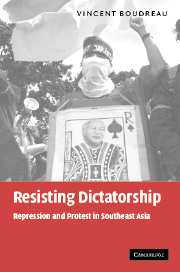Book contents
- Frontmatter
- Contents
- List of maps
- Acknowledgments
- List of abbreviations
- 1 Introduction
- 2 Protest, repression and transition in Southeast Asia
- 3 Authoritarian attack and dictatorial rise
- 4 Protest in socialist Burma
- 5 New Order repression and the Indonesian opposition
- 6 The Philippine new society and state repression
- 7 Repression and protest in comparative perspective
- 8 People power and insurgency in the Philippine transition
- 9 Protest and the underground in Burma
- 10 Indonesia's democracy protests
- 11 Democracy protest and state repression
- List of references
- Index
8 - People power and insurgency in the Philippine transition
Published online by Cambridge University Press: 15 December 2009
- Frontmatter
- Contents
- List of maps
- Acknowledgments
- List of abbreviations
- 1 Introduction
- 2 Protest, repression and transition in Southeast Asia
- 3 Authoritarian attack and dictatorial rise
- 4 Protest in socialist Burma
- 5 New Order repression and the Indonesian opposition
- 6 The Philippine new society and state repression
- 7 Repression and protest in comparative perspective
- 8 People power and insurgency in the Philippine transition
- 9 Protest and the underground in Burma
- 10 Indonesia's democracy protests
- 11 Democracy protest and state repression
- List of references
- Index
Summary
Many descriptions of the 1986 Philippine anti-Marcos rebellion emphasize the largely mistaken notion that an unorganized force (more moral than political, in the Indonesian sense) swept the dictator from office. This impression, however, neglects how organized political struggle against the regime maneuvered to set up this transition. In that process, each side strove to polarize Philippine society in ways that would leave its opponent isolated and vulnerable to direct violence: authorities looked to isolate the NDF by co-opting moderates away from potentially broad revolutionary alliances, while the left sought to recruit among the political center by demonstrating the limits of state-sponsored reform and the wisdom of the revolutionary alternative. Still, the regime did not end in violent revolution, nor did authorities launch a military counterstrike against anti-dictatorship protests. Non-violent protests supporting military defectors and fortified by domestic and international pressures did Marcos in, and he left office without a bloodbath. Here, then, we find a puzzle: with the regime and its most organized and apparently powerful opponents both angling for social polarization and one another's violent dispatch, what explains the peaceful transition in which neither prospered?
The answer lies in how cycles of reform and repression under Marcos nurtured open and semi-legal anti-dictatorship organizations. Marcos continued to try dividing moderate and elite dissidents from those who adopted armed underground struggle, though the boundary between these camps constantly shifted, often as moderates radicalized following regime repression.
- Type
- Chapter
- Information
- Resisting DictatorshipRepression and Protest in Southeast Asia, pp. 176 - 189Publisher: Cambridge University PressPrint publication year: 2004



